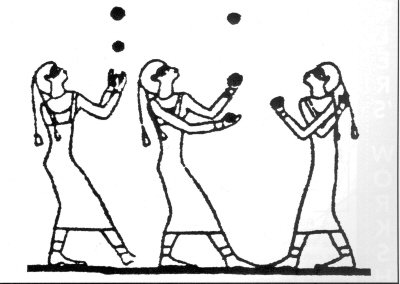
The first Mills Mess? From the Hassen Tomb, Middle Kingdom Period, 2000 -1780 B.C. |
Page 31 Winter 1994 - 95
|
Academic Juggler
A
Messy History and Other Academic Notes BY
ARTHUR LEWBEL
This
column investigates the history of Mills mess. Before this messy tale,
The
MIT juggling club in Cambridge, Massachusetts is now twenty years old!
It is the oldest juggling club (though not the oldest juggling school)
in continuous operation in North America, and possibly the world. I
and some friends started the MIT juggling club in 1975, inspired by a
combination of John Grimaldi's juggling club which met at Trinity
church off Wall Street in New York City, and the MIT unicycle club
that was started by Andy Rubel in 1974. By 1976 MIT was one of only
four juggling clubs listed in the IJA Newsletter, the publication that
preceded Jugglers World. The others were Grimaldi's New York club, the
Pioneer Valley juggling association in Amherst, Massachusetts, and the
MacArthur Park jugglers in Los Angeles. After 20 years, the MIT club
is still going strong, and still meeting on Sunday afternoons (in the
Lobby of building 10 at MIT, or outdoors by the Student center).
In
other Academic juggling
Colin
is one of the inventors of site swap notation, which is the real
subject of the article. See Tiemann and Magnussen in the Summer
1991 Jugglers World for an introduction to site swaps. The terms
"drops" and "descents" that appear in the title
are puns, having specialized meanings in the mathematical group theory
used in the article. The main result they derive is that the number of
different site swap patterns for b or fewer balls which
are exactly n numbers long equals b raised
to the power n. While simple to state, this result is
surprisingly difficult to prove.
In
response to popular demand, my offer from the last Academic Juggler
still stands. Send me a self addressed, stamped (with
I
claimed in the last Academic Juggler
that in the early 1970s Steve Mills learned a Ron Lubman three ball
trick that he then convened into what is now known as Mills Mess.
After that article came out Ron Graham called me to say that it was he
who had given Steve the initial idea. Ron Graham is a former IJA
president, a world famous mathematician, a coauthor of the Drops and
Descents paper described above, and the Guinness book world
So
what is the true story of Mills Mess? Apparently Graham experimented
with many patterns that crossed hands or changed direction in the Mess
way, some of which were likely to be close to the current Mess: Steve
studied Ron's patterns,
Ron
and Steve juggled at the YMCA in Morristown, N.J., when the mess was
created, but the name "Mills Mess" was given to this trick
some years later on the West coast by Ed Jackman, Barrett Felker, and /
or Norm Johnson. No one seems to know exactly when the trick was
invented or named, but I saw Steve show it, without a name, at John
Grimaldi's New York City Juggling Club in 1974.
After
seeing the Mess this first time, I went home and tried to learn it.
Later, when I saw Steve again and showed him the trick. He said, "I
don't know what you're doing." I had unintentionally invented a
different messy trick, and had to start over learning the real Mess.
One
reason for the popularity of Mills Mess is that, while relatively easy
to learn, it looks dazzlingly complicated, and is almost impossible to
describe in words. This hasn't stopped people from trying. For example,
many descriptions of the trick have appeared in rec.juggling on the Internet (see the IJA news in the Fall 1994 Jugglers World for information about Juggling on the internet.
The
first written attempt to describe
A
THREE BALL TRICK. At the 1976 convention Steve Mills was teaching a
relatively complex three ball trick to many of the conventioneers, many
of whom seemed to be having trouble understanding what he was saying.
Apparently, this same trick has been the subject of much instruction at
previous conventions. I think I've got it now, and a written description
follows...
I
won't repeat Dave's description here. The Mills Mess really should be
seen to be learned.
The
Steve Mills and family authorized spelling of the trick is "Mills
Mess," rather than Mill's, Mills' or Mills's mess. I won't accept
responsibility for the anguish this may cause among punctuation purists.
According
to Bob Nickerson, "Jugglers are not efficiency experts. They're
always saying:. There's got to be a harder way to do this."
Nickerson's claim definitely applies to Mills Mess, where in addition to
the four and five ball Mills Mess, some jugglers do Mills Messed site
swaps. One can also see site swaps and any number of balls done the
Mills Mess way on Ed Carsten's computer program "JugglePro."
Mills
Mess has inspired many other alliterative, eponymous juggling tricks,
the most famous being Eric's Extension, Burke's Barrage, and
Rubenstein's Revenge. Each adds more confusion or difficulty to the
original Mess.
Like
America with Columbus, the question of who found the Mess first can
never be known for sure. Mills Mess may have been discovered and
forgotten many times before Steve found it and made it famous. Do you
suppose these women from the Hassan tomb could have been The
Academic Juggler is an
occasional |

The first Mills Mess? From the Hassen Tomb, Middle Kingdom Period, 2000 -1780 B.C. |